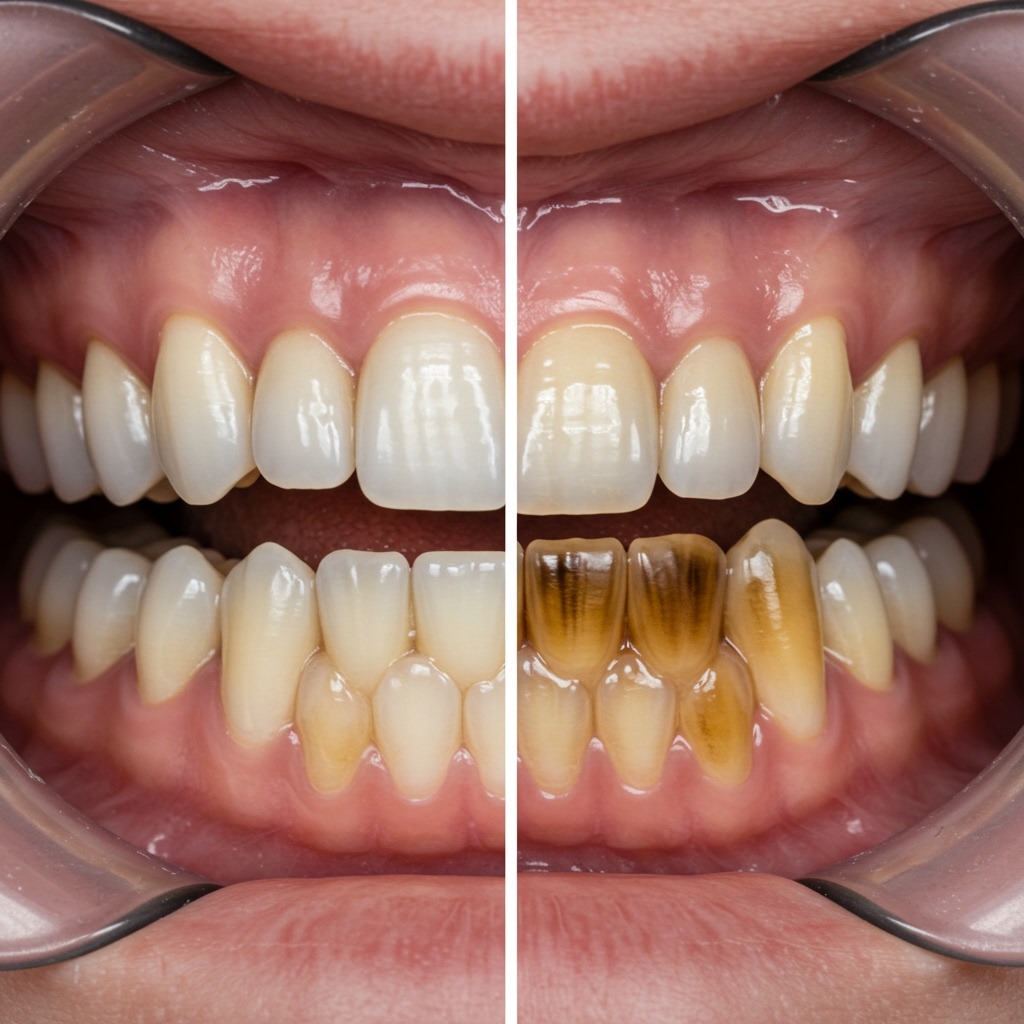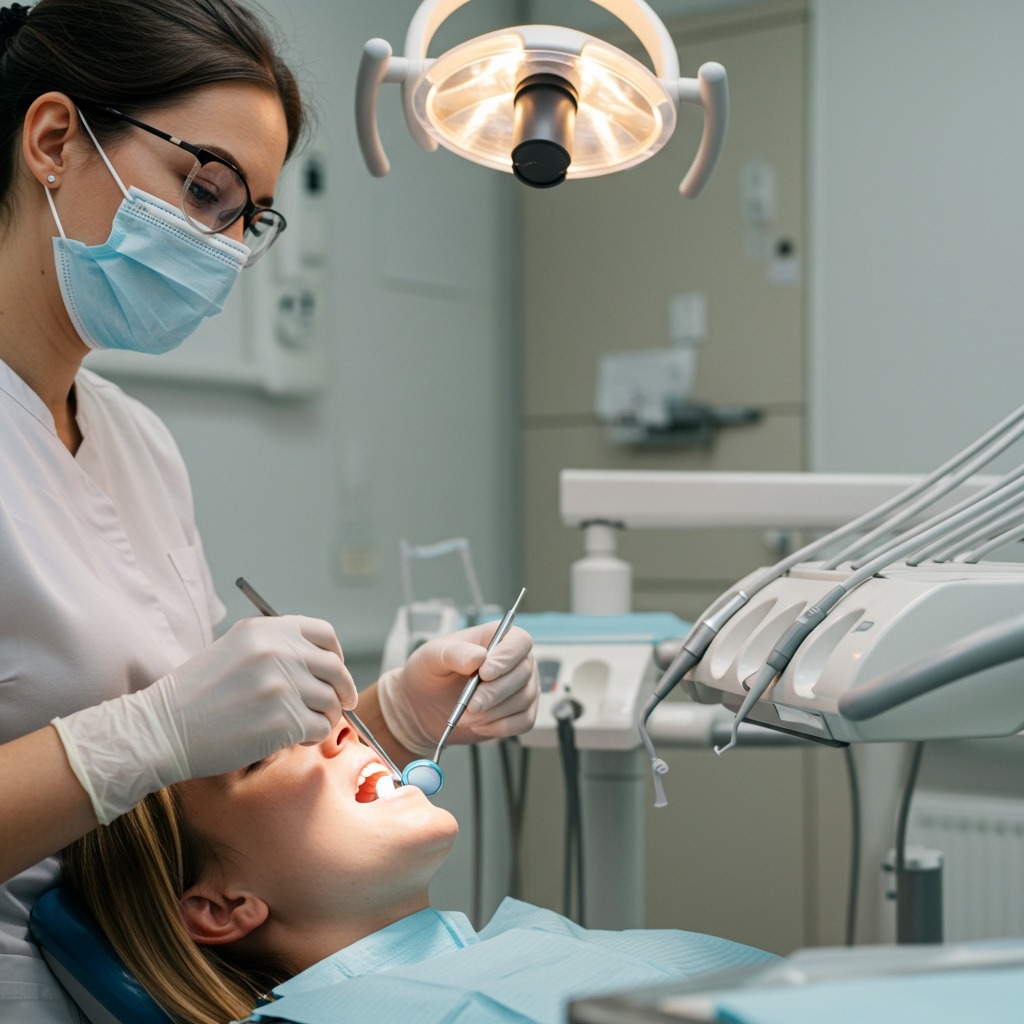That morning cup of coffee. For many, it’s a non-negotiable ritual, a warm hug in a mug that kickstarts the day. But as you sip that dark, rich brew, a nagging question might pop into your head: does coffee stain your teeth?
It’s a common concern, and you’re right to wonder. You love your coffee, but you also love a bright, confident smile. So, what’s the deal? Are your daily doses of java dooming you to a dull, discolored grin?
Let’s get straight to it. Yes, unfortunately, coffee does have the potential to stain your teeth. But don’t despair and definitely don’t spit out that latte just yet! Understanding how and why it happens is the first step to minimizing its impact and keeping your pearly whites, well, pearly.
Why Your Pearly Whites Aren’t Immune to Coffee
So, you’re wondering, “does coffee stain your teeth, and if so, how does this happen?” The main culprits are compounds within coffee called tannins.
Tannins are a type of polyphenol, which are naturally occurring organic compounds. They’re also found in other well-known stainers like red wine, tea, and dark berries. Here’s the science bit, made simple:
- Enamel’s Porous Nature: Your tooth enamel, the hard, outer layer of your teeth, might seem smooth and impenetrable. However, on a microscopic level, it’s actually quite porous, with tiny pits and ridges.
- Tannins Love to Stick: When you drink coffee, these tannins (which are also chromogens, meaning they produce color) get into those microscopic imperfections.
- Color Accumulation: Over time, as these color compounds accumulate, they can lead to a yellowish or brownish tint on your teeth. Think of it like a white t-shirt repeatedly getting small splashes of a colored liquid – eventually, those splashes build up and become noticeable.
- Acidity Plays a Role: Coffee is also acidic. This acidity can slightly erode your tooth enamel over time, making it rougher and even more susceptible to staining because the tannins have an easier surface to adhere to. It’s a bit of a one-two punch.
So, the answer to “does coffee stain your teeth?” is a clear yes, thanks to these tenacious tannins and coffee’s acidic nature.
Are Some Coffees Worse Than Others?
You might be thinking, “Okay, coffee stains teeth. But does the type of coffee I drink make a difference?”
Potentially, yes.
- Darker Roasts: Generally, the darker the roast, the more chromogens it might contain, potentially leading to more staining. However, some argue that darker roasts can sometimes be less acidic.
- Brewing Method: The concentration of your coffee matters. Stronger brews like espresso, or coffee that has been steeping for a long time (like in a French press if left too long), might have a higher concentration of tannins.
- Additives: What you add to your coffee can also play a part, though not always directly in staining from the coffee itself. Sugary additions can contribute to overall dental health issues, which might indirectly make teeth more vulnerable. We’ll touch more on this later.
The core issue remains the tannins, and they’re present in all coffee. So, while some variations might have a slightly lesser or greater impact, no coffee is entirely stain-proof.
It’s Not Just Coffee: Other Culprits in Tooth Discoloration
While we’re focused on the question “does coffee stain your teeth?”, it’s important to remember that coffee isn’t the only bad guy in the lineup of tooth stainers. If you’re concerned about discoloration, be mindful of these too:
- Tea: Black tea, in particular, can be even more staining than coffee due to its higher tannin content.
- Red Wine: Another notorious stainer, rich in chromogens and tannins.
- Dark Sodas & Colas: The colorants and acids in these drinks are double trouble.
- Berries & Dark Fruit Juices: Think blueberries, blackberries, pomegranates – delicious, but potent stainers.
- Tomato Sauce & Soy Sauce: Highly pigmented and acidic sauces can contribute to staining over time.
- Tobacco Products: Smoking or chewing tobacco is a major cause of deep, stubborn tooth discoloration and, more importantly, significant health problems.
Understanding these other sources can help you manage your overall approach to preventing tooth stains.
Don’t Panic! How to Enjoy Coffee AND Keep Your Teeth Bright
Alright, so we’ve established the answer to “does coffee stain your teeth?” is yes. But before you consider a coffee-less existence (the horror!), know that there are plenty of practical, effective strategies you can use to minimize staining and keep your smile radiant.
1. Drink Water – Your Smile’s Best Friend:
- Rinse After Coffee: This is a big one. After finishing your coffee, take a good swig of water and swish it around your mouth. This helps to wash away those lingering coffee particles and acids before they have too much time to settle on your enamel.
- Stay Hydrated: Drinking water throughout the day, not just after coffee, promotes saliva production. Saliva is your body’s natural defense mechanism; it helps neutralize acids and wash away food particles and staining compounds.
2. The “When” and “How” of Brushing:
- Don’t Brush Immediately After: This might sound counterintuitive. You might think brushing right after coffee is the best way to combat stains. However, remember that coffee is acidic. If you brush immediately, you could actually be scrubbing those acids into your enamel, potentially causing more wear over time.
- Wait 30 Minutes: It’s generally recommended to wait about 30 minutes after consuming acidic foods or drinks (like coffee) before brushing your teeth. This gives your saliva a chance to neutralize the acids and for your enamel to slightly re-harden.
- Brush Thoroughly (But Gently!): When you do brush, use a soft-bristled toothbrush and fluoride toothpaste. Brush for at least two minutes, twice a day, ensuring you1 reach all surfaces of your teeth. Aggressive brushing won’t remove stains faster; it can actually wear down enamel and make your teeth appear more yellow as the underlying dentin (which is naturally yellowish) shows through.
3. Sip Smarter, Not Harder:
- Use a Straw: If you’re drinking iced coffee (or even hot coffee, if you’re careful!), using a straw can help bypass your front teeth, reducing their direct exposure to the coffee. This is a simple but effective trick.
- Don’t Nurse Your Coffee All Day: While it’s tempting to make that cup last for hours, prolonged exposure means your teeth are constantly bathed in those staining compounds and acids. Try to drink your coffee within a reasonable timeframe (e.g., 20-30 minutes) rather than sipping it continuously over several hours. If you do sip for longer, make rinsing with water even more of a priority.
4. Milk or Creamer – A Buffer?
- The Theory: Adding milk or creamer to your coffee might slightly lessen its staining power. The idea is that the proteins in milk can bind to tannins, potentially reducing the number of tannins available to stick to your teeth. It also lightens the color of the coffee.
- The Reality: While it might offer a marginal benefit in terms of color intensity, it’s not a foolproof solution. The tannins are still present. If you prefer your coffee black, don’t feel you must add milk solely for stain prevention if other habits are in place.
5. Regular Dental Check-ups and Cleanings:
- Professional Power: Your dental hygienist has the tools and expertise to remove surface stains that your regular brushing can’t tackle. Professional cleanings are essential for maintaining not just the brightness of your smile, but your overall oral health.
- Early Detection: Your dentist can also spot any early signs of enamel erosion or other issues that might make your teeth more susceptible to staining. They can provide personalized advice. How often you should visit can depend on your individual needs, but many people benefit from a check-up and cleaning every six months. You can learn more about what to expect at a routine dental visit from the American Dental Association.
6. Consider Whitening Options (If Needed):
If stains have already set in despite your best efforts, there are several whitening options available:
- Whitening Toothpastes: These typically contain mild abrasives to help scrub away surface stains or chemical agents like hydrogen peroxide to lighten tooth color. They can offer a modest improvement. Look for the ADA Seal of Acceptance for whitening toothpastes.
- Over-the-Counter Whitening Strips & Gels: These products contain a higher concentration of whitening agents (usually peroxide-based) than toothpastes and are applied directly to the teeth for a set period. They can be effective for more noticeable surface stains.
- Professional Whitening (In-Office or Take-Home Kits): For more significant or deeper stains, professional whitening treatments from your dentist are the most effective and safest option. In-office treatments use stronger whitening agents and may involve special lights to accelerate the process. Take-home kits from your dentist involve custom-fitted trays and professional-grade whitening gel.
Important Note on Whitening: Always consult your dentist before starting any whitening treatment, especially if you have sensitive teeth, dental restorations (fillings, crowns, veneers, as these won’t whiten), or gum disease. They can help you choose the best and safest option for your specific situation.
7. Don’t Forget Flossing!
Does coffee stain your teeth in between? Yes! Stains can accumulate in the tight spaces between your teeth where your toothbrush bristles can’t easily reach. Flossing daily helps remove plaque and food particles from these areas, reducing the chances of discoloration (and cavities and gum disease!).
Read more: Is Coffee Gluten Free? Your Guide to Safe Sipping
Does Coffee Stain Your Teeth Permanently?
This is a crucial follow-up question to “does coffee stain your teeth?”. The good news is that most coffee stains are extrinsic, meaning they are on the surface of the enamel. These types of stains are generally removable with good oral hygiene, professional cleanings, and whitening treatments if necessary.
However, if enamel erosion is significant (due to acidity from coffee and other sources, aggressive brushing, etc.), it can expose the underlying dentin. Dentin is naturally more yellow than enamel. Stains that involve the dentin (intrinsic stains) are much harder to remove and may require more intensive cosmetic dental procedures.
This is why prevention and good oral hygiene are so important – they help protect your enamel and keep stains primarily on the surface where they are manageable.
The Bottom Line: Enjoy Your Brew, But Be Mindful
So, does coffee stain your teeth? Yes, it does. But does that mean you need to give up your beloved beverage? Not necessarily.
By understanding why coffee stains and by implementing these practical, preventative strategies, you can continue to enjoy your coffee while minimizing its impact on the brightness of your smile. It’s all about balance and good habits.
- Rinse with water after your coffee.
- Wait 30 minutes before brushing.
- Maintain excellent oral hygiene (brushing, flossing).
- See your dentist regularly.
- Consider using a straw and not sipping all day long.
With a little care, you can have your coffee and a bright smile too.
Frequently Asked Questions (FAQ) – Does Coffee Stain Your Teeth?
Q1: Is coffee the worst drink for teeth staining?
A: While coffee is a significant stainer, black tea often contains more tannins and can be even more prone to causing stains. Red wine is also a major culprit.
Q2: Will switching to iced coffee reduce staining?
A: Drinking iced coffee, especially with a straw, can help reduce direct contact with your front teeth, potentially lessening staining on those visible surfaces. However, the coffee itself still contains tannins.
Q3: Does adding milk to coffee prevent teeth stains?
A: Adding milk may slightly reduce the staining potential by lightening the coffee’s color and possibly by milk proteins binding to some tannins. However, it’s not a complete preventative measure. The coffee still has staining capabilities.
Q4: How quickly can coffee stain teeth?
A: Staining is a gradual process. You’re unlikely to see noticeable stains after just one cup. It happens over time with consistent exposure. The speed can depend on your oral hygiene, enamel porosity, and how much coffee you drink.
Q5: Can coffee stains be completely removed?
A: Most surface (extrinsic) stains from coffee can be removed with regular professional cleanings and good at-home oral hygiene. More stubborn stains may require whitening treatments. If staining is intrinsic (below the enamel), it’s more challenging to remove.
Q6: Are there “stain-free” coffees?
A: Some companies market “clear coffee” or “white coffee” (which is very lightly roasted and has a different flavor profile) with claims of less staining. While they may be lighter in color, the compounds that can contribute to staining might still be present to some degree. The fundamental chemistry of coffee involves compounds that can discolor.
Q7: Does the acidity of coffee contribute more to damage than staining?
A: The acidity of coffee contributes to both. It can slowly erode enamel, making teeth rougher and more porous. This rougher surface then picks up the staining tannins more easily. So, the acidity makes teeth more susceptible to staining and can also lead to sensitivity and other dental issues over time.



